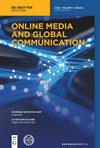情感共同体与协同行动:论香港反引渡法修订运动中虚假信息的情感动员机制
引用次数: 0
摘要
摘要随着计算宣传的大规模应用,全球范围内出现了虚假信息运动,以回应“后真相”政治的逻辑。有组织的虚假信息活动经常在海外社交媒体平台上进行,中国经常成为攻击目标。为了了解此类虚假信息运动的传播机制,研究发现,传播虚假信息成为该运动情感动员的关键策略。虚假信息的主体已经形成了一个国际传播矩阵,大规模制造和传播各种虚假信息。“抗议者联盟”基于虚假信息引发的共同情感体验,其特点是传播虚假信息。然后,相应情绪的广泛传播导致了对“目标”的不同认知,从而促使抗议者采取不同类型的集体行动。这种情绪动员机制表明,事实“太大了,不知道”,这加剧了确认偏见,并为虚假信息的传播提供了更多空间。虚假信息中嵌入的强烈情绪有助于完成抗议者对社区的想象,情绪成为凝聚群体和为集体行动提供动力支持的主导因素。本文章由计算机程序翻译,如有差异,请以英文原文为准。
Emotional community and concerted action: on the emotional mobilization mechanism of disinformation in the Anti-extradition Law amendment movement in Hong Kong
Abstract With the large-scale application of computational propaganda, disinformation campaigns have emerged globally in response to the logic of “post-truth” politics. Organized disinformation campaigns operate frequently on overseas social media platforms, with China often being the target. In order to understand the dissemination mechanisms of such disinformation campaigns, the study found that the dissemination of disinformation became a key strategy for the campaign’s emotional mobilization. The main subjects of disinformation have formed an international communication matrix, creating and spreading all kinds of disinformation on a large scale. The “coalition of protesters” is based on the shared emotional experience evoked by disinformation and characterized by the act of spreading disinformation. Then, the widespread dissemination of the corresponding emotions leads to different perceptions of the “target,” thus prompting protesters to adopt different types of collective action. This mechanism of emotional mobilization shows that facts are “too big to know,” which exacerbates confirmation bias and provides more space for the spread of disinformation. The strong emotions embedded in disinformation contributed to the completion of the protesters’ imagination of community, and emotions became the dominant factor in coalescing the group and providing motivational support for collective action.
求助全文
通过发布文献求助,成功后即可免费获取论文全文。
去求助
来源期刊

Online Media and Global Communication
Communication, Media Studies, Internet Studies, International Studies, International Relations-
自引率
0.00%
发文量
0
期刊介绍:
Online Media and Global Communication (OMGC) is a new venue for high quality articles on theories and methods about the role of online media in global communication. This journal is sponsored by the Center for Global Public Opinion Research of China and School of Journalism and Communication, Shanghai International Studies University, China. It is published solely online in English. The journal aims to serve as an academic bridge in the research of online media and global communication between the dominating English-speaking world and the non-English speaking world that has remained mostly invisible due to language barriers. Through its structured abstracts for all research articles and uniform keyword system in the United Nations’ official six languages plus Japanese and German (Arabic, Chinese, English, French, Russian, Spanish, Japanese, and German), the journal provides a highly accessible platform to users worldwide. Its unique dual track single-blind and double-blind review system facilitates manuscript reviews with different levels of author identities. OMGC publishes review essays on the state-of-the-art in online media and global communication research in different countries and regions, original research papers on topics related online media and global communication and translated articles from non-English speaking Global South. It strives to be a leading platform for scientific exchange in online media and global communication.
For events and more, consider following us on Twitter at https://twitter.com/OMGCJOURNAL.
Topics
OMGC publishes high quality, innovative and original research on global communication especially in the use of global online media platforms such as Facebook, TikTok, YouTube, Twitter, Instagram, WhatsApp, Weibo, WeChat, Wikipedia, web sites, blogs, etc. This journal will address the contemporary concerns about the effects and operations of global digital media platforms on international relations, international public opinion, fake news and propaganda dissemination, diaspora communication, consumer behavior as well as the balance of voices in the world. Comparative research across countries are particularly welcome. Empirical research is preferred over conceptual papers.
Article Formats
In addition to the standard research article format, the Journal includes the following formats:
● One translation paper selected from Non-English Journals that with high quality as “Gems from the Global South” per issue
● One review essay on current state of research in online media and global communication in a country or region
 求助内容:
求助内容: 应助结果提醒方式:
应助结果提醒方式:


